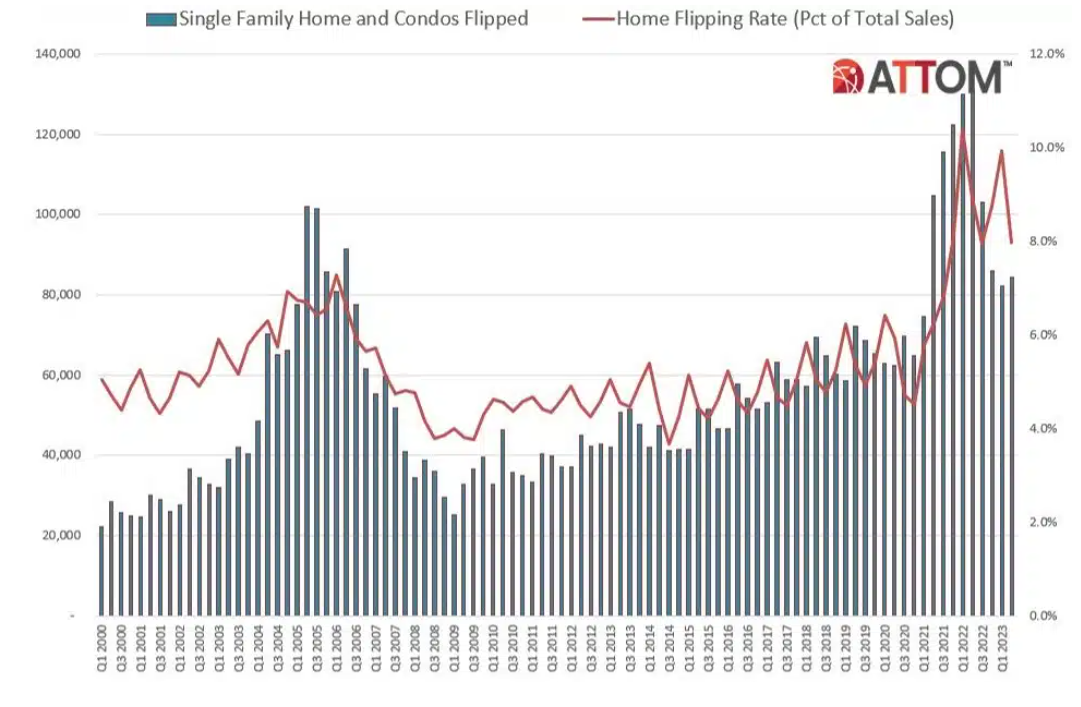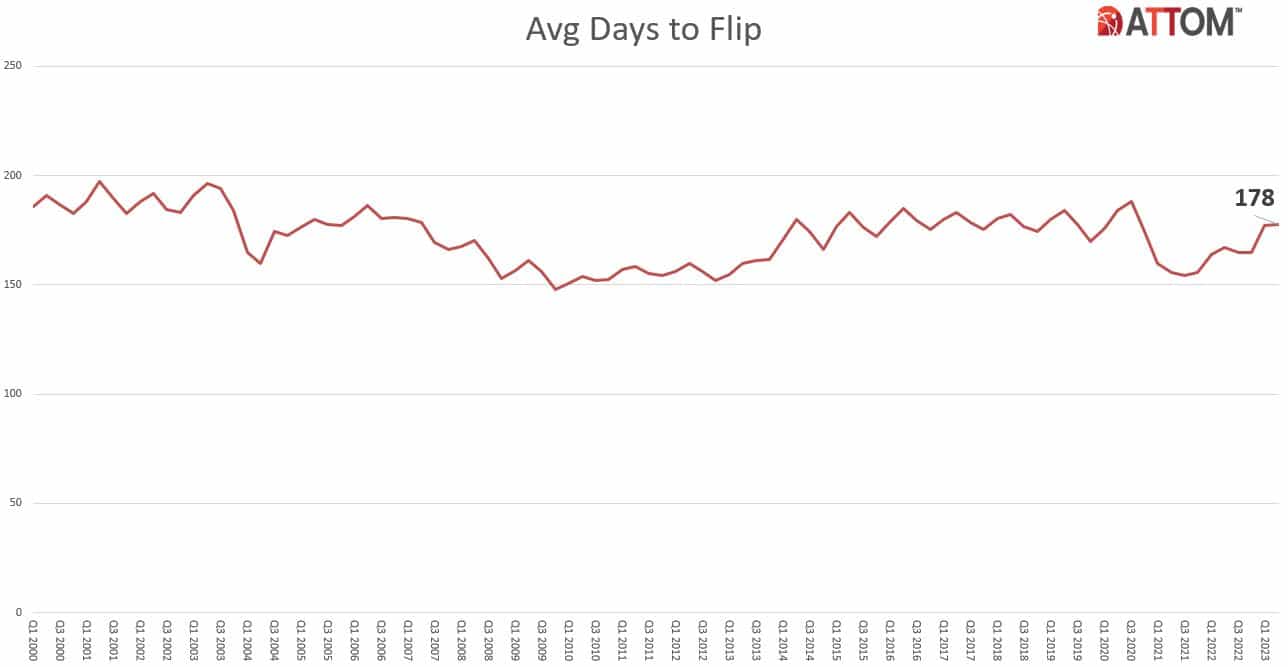 ATTOM has released its Q2 2023 U.S. Home Flipping Report revealing that 84,350 single-family homes and condos in the U.S. were flipped in the second quarter of the year. Those transactions represented 8%, or one of every 13 home sales, during the months of April through June of 2023.
ATTOM has released its Q2 2023 U.S. Home Flipping Report revealing that 84,350 single-family homes and condos in the U.S. were flipped in the second quarter of the year. Those transactions represented 8%, or one of every 13 home sales, during the months of April through June of 2023.
Q2’s report was down from 9.9% of all home sales in the nation during Q1 of 2023, and from 8.9% in Q2 of last year. Despite the flipping rate remaining historically high, it dropped to nearly its lowest point since 2021.
ATTOM’s Q2 2023 U.S. Home Flipping Report also found that even as flipping activity decreased, investor profits and profit margins both showed more signs of recovering from a slump that had slashed them by more than half in just two years. Both increased for the second consecutive quarter, with investment returns climbing at their fastest pace since 2020, and raw profits spiking more than at any point over the past decade.

The typical profit margin, while still far below peaks last reported in 2021, rose nearly five percentage points from Q1 to Q2 of this year. Raw profits on typical flips, meanwhile, shot up 18% quarterly.
The home-flipping profit improvement came amid a rebound in the broader U.S. housing market, which saw the single-family median home price spike 10% during the Spring buying season, after falling from the middle of last year to the early part of 2023.
"Fortunes for investors who flip homes for quick profits are showing more signs of turning around after a long and unusual period when they went down while the rest of the market went up," said Rob Barber, CEO for ATTOM. "However, the latest investment returns may not be substantial enough to cover the holding costs on typical deals. And it's still too early to declare the profit downturn over, as much will depend on whether the second-quarter market surge keeps going or whether it retreats again like it did last year."
Among flips nationwide, the gross profit on typical transactions (the difference between the median purchase price paid by investors and the median resale price) increased to $66,500 in Q2 of 2023. That remained down 35% from $102,063 in Q2 of 2022, and still stood at one of the lowest points in the past five years, but it was up from $56,250 in Q1 of this year.
The typical gross flipping profit translated into a 27.5% return-on-investment (ROI) compared to the original acquisition price in Q2 of 2023. That also was still far below a highwater mark of 61% on median-priced flips reached in Q2 of 2021. But it was up from 22.9% in Q1 of this year as well as from a recent low of 22.3% hit in Q4 of last year.
Profits and profit margins continued to revive in Q2 of 2023, as investors were able to take advantage of shifts in prices that went in their favor from the point when they were buying their properties to when they sold them. Specifically, the typical resale price on flipped homes increased to $308,500 in Q2, a 2.1% over Q1 of 2023. That contrasted with a 1.6% decrease in median prices that recent home flippers were commonly seeing when they were buying their properties. The price shift–from a decrease to an increase–led to the improvement in profits and profit margins.
Home flips as a portion of all home sales decreased from Q1 of 2023 to Q2 of 2023 in 168 of the 190 metropolitan statistical areas around the U.S. with enough data to analyze (88%). Flipping rates dropped at least two percentage points in more than a third of the metros reviewed. Metro areas were included if they had a population of 200,000 or more and at least 50 home flips in Q2 of 2023.
Among those metros, the largest flipping rates during Q2 of 2023 were found in:
- Macon, Georgia, where flips comprised 16.8% of all home sales;
- Columbus, Georgia, where flips comprised 15.3% of all home sales;
- Spartanburg, South Carolina, where flips comprised 13.5% of all home sales;
- Atlanta, where flips also comprised 13.5% of all home sales; and
- Akron, Ohio, where flips comprised 12.5% of all home sales.
Aside from Atlanta, the largest flipping rates among metro areas with a population of more than one million were found in:
- Memphis(12.5%);
- Jacksonville, Florida (11.1%);
- Cincinnati (11%); and
- Phoenix (10.9%).
The smallest home-flipping rates among metro areas analyzed in Q2 were found in:
- Seattle (3.7%);
- Santa Rosa, California (4%);
- San Jose (4.2%);
- San Francisco (4.3%); and
- Hilo, Hawaii (4.3%).
The median $308,500 resale price of homes flipped nationwide in Q2 of 2023 generated a gross profit of $66,500 above the median investor purchase price of $242,000, resulting in a typical 27.5% profit margin in Q2 of 2023, up from Q1, but still below the 44.6% level in Q2 of 2022, and 60.8% in the same period of 2021.
Profit margins went up from Q1 to Q2 in 119 of the 190 metro areas analyzed (63%), but they were still less than typical returns from a year earlier in 163, or 86%, of those markets.
The biggest increases in the typical profit margins during Q2 of 2023 came in:
- Trenton, New Jersey (ROI up from 11.3% in Q1 of 2023 to 85% in Q2 of 2023);
- Akron, Ohio (up from 50% to 116.7%);
- Montgomery, Alabama (up from 30.8% to 78.8%);
- Champaign, Illinois (up from 10.5% to 53.9%); and
- Hagerstown, Maryland (up from 45.6% to 86.6%).
Despite the quarterly gains, typical flipping profits remained less than 30% in 79 of the 190 metros with enough data to analyze in Q2 of 2023—worse than a year earlier, when just one of every five of those metro areas commonly had returns that low.
Markets with the largest ROI for typical home flips completed during Q2 of 2023 were found in:
- Akron, Ohio (116.7% ROI);
- Pittsburgh (112.9% ROI);
- Scranton, Pennsylvania (93.7% ROI);
- Hagerstown, Maryland (86.6% ROI); and
- Trenton, New Jersey (85% ROI).
Aside from Pittsburgh, the largest investment returns in the second quarter among metro areas with a population of at least one million were reported in:
- Baltimore, Maryland (79.3%);
- Philadelphia (76.9 %);
- Rochester, New York (76.2%); and
- Richmond, Virginia (75.5%).
Metro areas with a population of at least one million and the weakest returns on typical home flips in Q2 of 2023 were found in:
- Austin, Texas (3.3% loss);
- Phoenix (4.9% gain);
- Salt Lake City (6% gain);
- Dallas (6.7% gain); and
- San Antonio (6.8% gain).
The highest raw profits on median-priced home flips in Q2 of 2023, measured in dollars, remained concentrated in the South and Northeast regions of the country, with 15 of the top 20 were in those regions, led by:
- San Jose (typical gross profit of $288,750);
- San Francisco (typical gross profit of $177,500);
- Vallejo, California (typical gross profit of $170,000);
- San Diego (typical gross profit of $166,500); and
- Boston (typical gross profit of $165,000).
The South also dominated the opposite end of the range, along with the West, with the 20 lowest raw profits on median-priced transactions located in those regions, with the weakest numbers found in:
- Austin, Texas ($14,814 loss);
- Reno, Nevada ($6,625 loss);
- Killeen, Texas ($2,476 profit);
- Provo, Utah ($6,009 profit); and
- Lubbock, Texas ($6,130 profit).
Nationwide, 62.6% of homes flipped in Q2 of 2023 had been purchased by investors with cash, down from 66% in Q1 of 2023, but about the same as the 62.7% portion reported in Q2 of 2022. Meanwhile, 37.4% of homes flipped in Q2 of 2023 had been bought with financing. That was up from 34% in the prior quarter, but virtually unchanged from 37.3% a year earlier.
"The second-quarter dip in all-cash flips came during a brief period when mortgage rates were declining a bit after spiking during the prior year," Barber noted. "With rates now rising again, there will be more pressure on investors to use cash to finance their activity. The third quarter should reveal more about that trend."
Among metropolitan areas with a population of one million or more and sufficient data to analyze, those with the highest percentage of flips in Q2 of 2023 that had been purchased with cash were reported in:
- Detroit (82.9%);
- Buffalo, New York (76.9%);
- Cleveland (74.4%);
- Cincinnati (73.8%); and
- Indianapolis (73.2%).
The average time it took from purchase to resale on home flips rose to 178 days in Q2 of 2023, up from 177 in Q1 of 2023, and 167 days in Q2 of 2022, to the largest amount since mid-2020.

Of the 84,350 U.S. homes flipped in Q2 of 2023, 11.9% were sold to buyers using loans backed by the Federal Housing Administration (FHA), marking the fourth straight quarterly gain. The latest portion was up from 10.8% in the prior quarter, and 7.6% a year earlier, to the highest figure since Q3 of 2020.
Among metro areas with a population of at least 200,000 and at least 50 home flips in Q2 of 2023, those with the highest percentage of flipped properties sold to FHA buyers—typically first-time home purchasers—were found in:
- Yuma, Arizona (29.1%);
- Lakeland, Florida (27.5%);
- Springfield, Massachusetts (23.4%);
- Modesto, California (22.5%); and
- Scranton, Pennsylvania (22.1%).
Home flips accounted for at least 10% of all home sales in 245, or 24%, of the 1,025 counties around the U.S. with at least 10 flips in Q2 of 2023, below the 36% of all counties with enough data to measure in Q1 of 2023. The leaders in Q2 of this year were found in:
- Cobb County (Marietta), Georgia (22.6%);
- Rockdale County, Georgia (outside Atlanta) (20.9%);
- Dorchester County (Cambridge), Maryland (18.8%);
- Houston County (Warner Robins), Georgia (18.8%); and
- Paulding County, Georgia (outside Marietta) (18.5%).

 DSNews The homepage of the servicing industry
DSNews The homepage of the servicing industry









